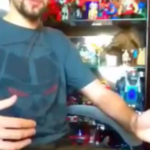When proud parents bring their babies home, they marvel at those tiny smiles and play with those twinkling toes. They can see Grandma’s eyes, Grandpas toes and Uncle Charlie’s dimples, but there is harm in thinking that babies are just like pint sized versions of adults. Babies are as fragile as they are beautiful and even the simplest thing, such as cleaning wax from ears, takes special consideration.
What is Ear Wax?
It’s yellowish-orange and sticky! But, it’s nothing like honey. The medical term for ear wax is cerumen, and cerumen is actually nature’s way of protecting ears. It is formed from glands that line the ear canal. Ear wax protects the sensitive lining of the ear against water and also prevents dirt and other foreign substances from entering the ear. Ear wax also have infection fighting properties.
However sometimes, the ear friend can be an ear foe if it becomes excessive and plugs the ear. Blockage can cause irritation, pain, and interfere with hearing. Monitoring ear wax in an infant is important.
When to Clean and What Not to Do
Some folks will advise that the best way to handle earwax is not to handle it. Some ear wax is good for your child. However, if you check your child’s ears regularly, check for build up and any changes in the color of your child’s ear. Also, observe your child’s habits. Is your child cranky and fiddling with their ear.
Remember wax can build up as a sign of inner irritation. It can block the ear canal. Fishing for wax is not like fishing for gold. You can do damage to your child if not careful. Q-tips and other common products are great for outer ear cleaning. However, if used internally, they could cause eardrum punctures or ruptures. Fingers are not appropriate to place inside an infant’s ear and like W-tips can often push wax deeper into the ear canal causing blockage. Suction blubs should be used with caution because they can cause pain and discomfort. If not used properly, the suction bulb can actually injure the middle ear.
Safe Cleaning Techniques – Cloth, Drops or Scoop
Cloth
A very common and safe way to clean your baby’s precious little ears is using a damp cloth. Bath time is generally a good time to do this. During your baby’s bath, ear wax becomes soften and will drain from his or her tiny ears. As it does, take a warm cloth and delicately clean your baby’s ears. Clean the exterior parts of the ear and then dab any draining wax. Do not insert the cloth deep into your child’s ear.
Drops
In some instances, the warm bath may not soften wax that has hardened inside your babies ears. This cerumen will need to be softened or broken up to help it drain from baby’s ear. There are a number of over the counter ear drops that can be used. Be mindful that some over the counter drops can be oily and may not flow as deeply into the ear as necessary. Do not substitute bath water as your ear flush. Many families use a home mixture of hydrogen peroxide and water as an ear flush.
When using ear drops or flushes, you can try using this method during bath time, but it’s not necessary. Just be sure your baby is lying on his or her side. Warm for drops or flush and place the drops/flush in your child ears. For drops, follow the instructions carefully. The goal is to allow the drops or flush to flow deeply into the ear. Be patient and allow the drops time to soften the wax. This could mean waiting five minutes or so. Let the drops or flush flow out and the wax should drain as well. Parents can repeat this process a few times to insure all hardened wax is removed. Once sure, a lukewarm bath should be sufficient to maintain a healthy wax level in your child’s ears. However, if the hardened wax does not drain, it’s time to seek medical advice from your pediatrician.
Medical Assistance- Pediatricians and ENT Specialists
Thick and hardened wax build up in infants can be a sign of something more serious. It can also lead to more issues down the road for your child. Make an appointment for your child to see his or her pediatrician.
Your pediatrician can examine your child’s ears for infection, build-up and other issues. The pediatrician has child friendly tools, such as an ear scoop, which can remove hardened wax from ears and remove impacted earwax plugs. However, if your pediatrician refers you to an Ear, Nose, and Throat (ENT) specialist who could employ small suction tools, an earwax scoop and an ear microscope.
Other considerations
Babies learn by imitation. The habits you use to clean their ears could be imitated by them as they get older. Be mindful that you are not inserting objects in their ears, because they will do the same.
Also, for recurrent ear blockage problems, you may want to have ear drops handy and add an ear flush regimen added to your child’s standard care. Flushing may only be needed once or twice a month to deal with major build-up.
Also, if foreign objects get placed in your child’s ear, immediately notify your doctor and take your child to the emergency room.
Also, resources for new parents can be found at the American Academy of Pediatrics website or the American Board of Pediatrics websites.
Babies don’t come with instruction manuals, and every parent stresses about keeping their children safe and healthy. Knowing how to properly clean an infant’s ears and how to identify warning signs of bigger problems is an important part of that process. Ear wax can be a friend, but when it becomes a foe, new parents can know what to do. Healthy ears lead to a healthy life.


